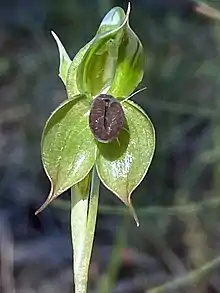| Illawarra rustyhood | |
|---|---|
 | |
| In bushland at Albion Park | |
| Scientific classification | |
| Kingdom: | Plantae |
| Clade: | Tracheophytes |
| Clade: | Angiosperms |
| Clade: | Monocots |
| Order: | Asparagales |
| Family: | Orchidaceae |
| Subfamily: | Orchidoideae |
| Tribe: | Cranichideae |
| Genus: | Pterostylis |
| Species: | P. gibbosa |
| Binomial name | |
| Pterostylis gibbosa | |
| Synonyms[1] | |
Pterostylis gibbosa, commonly known as the Illawarra rustyhood,[2] or Illawarra greenhood,[3] is a plant in the orchid family Orchidaceae and is endemic to New South Wales. It has a rosette of leaves at its base and up to nine bright green flowers with translucent "windows", relatively wide lateral sepals with short-pointed tips and a dark, fleshy, insect-like labellum.
Description
Pterostylis gibbosa, is a terrestrial, perennial, deciduous, herb with an underground tuber. It has a rosette of between four and seven egg-shaped leaves 15–35 mm (0.6–1 in) long and 8–15 mm (0.3–0.6 in) wide. Flowering plants have a rosette at the base of the flowering spike but the leaves are usually withered by flowering time. Up to nine bright green flowers with translucent panels and 20–23 mm (0.8–0.9 in) long, 11–13 mm (0.4–0.5 in) wide are borne on a flowering spike 150–450 mm (6–20 in) tall. The flowers lean forward and there are three to six stem leaves wrapped around the flowering spike. The dorsal sepal and petals form a hood or "galea" over the column with the dorsal sepal having a narrow tip 2–3 mm (0.08–0.1 in) long. The lateral sepals turn downwards, wider than the galea and which taper to narrow, brownish tips 2–3 mm (0.08–0.1 in) long. The labellum is fleshy, dark brown and insect-like, about 5 mm (0.2 in) long and 3–4 mm (0.1–0.2 in) wide with a channel along its mid-line. The "head" end is thick and has many short hairs and the "body" has four to eight longer hairs on each side. Flowering occurs from August to November.[2][4]
Taxonomy and naming
Pterostylis gibbosa was first formally described in 1810 by Robert Brown and the description was published in Prodromus Florae Novae Hollandiae et Insulae Van Diemen.[5][6] The specific epithet (gibbosa) is a Latin word meaning "very humped" or "crooked".[7]
Distribution and habitat
The Illawarra rustyhood grows in forest with grasses in scattered populations in the Hunter, Illawarra and Shoalhaven regions. It is no longer found on the Cumberland Plain where it was first collected.[2][3][4][8]
Conservation
Pterostylis gibbosa is listed as "endangered" under the Australian Government Environment Protection and Biodiversity Conservation Act 1999. The main threats to the species are urbanisation, grazing by domestic stock, weed invasion and inappropriate fire regimes.[8]
References
- 1 2 "Pterostylis gibbosa". World Checklist of Selected Plant Families (WCSP). Royal Botanic Gardens, Kew.
- 1 2 3 Jones, David L. (2006). A complete guide to native orchids of Australia including the island territories. Frenchs Forest, N.S.W.: New Holland. p. 324. ISBN 978-1877069123.
- 1 2 "Pterostylis gibbosa (R.Br.) Illawarra Greenhood Orchid" (PDF). N.S.W. National Parks and Wildlife Service. Retrieved 28 June 2017.
- 1 2 Jones, David L. "Pterostylis gibbosa". Royal Botanic Garden Sydney: plantnet. Retrieved 28 June 2017.
- ↑ "Pterostylis gibbosa". APNI. Retrieved 28 June 2017.
- ↑ Brown, Robert (1810). Prodromus florae Novae Hollandiae. London. p. 327. Retrieved 28 June 2017.
- ↑ Brown, Roland Wilbur (1956). The Composition of Scientific Words. Washington, D.C.: Smithsonian Institution Press. p. 633.
- 1 2 "Conservation advice Pterostylis gibbosa (Illawarra greenhood)" (PDF). Australian Government Department of the Environment. Retrieved 28 June 2017.
